The Democratic Republic of Congo has non-interconnected railways of 5,033 km. Three public institutions, the Commercial Company of Transports and Ports (SCTP), the Railways of Uélé and the Société Nationale des Chemins de Fer du Congo (SNCC), ensure investments, management and exploitation of the existing infrastructures.
The rail network is largely inherited from the colonial times and was renovated during the 1970s in some areas. The infrastructure is in poor condition, but the network manages to function despite considerable delays and numerous incidents (with the exception of the Railways of Uélé which is not operational).
4.1 Democratic Republic of Congo Government Contact List
Travel Time Matrix
This is an indicative and theoretical matrix: incidents and mechanical failures often delay trains by days.
|
Travel Time from Capital City to Major Towns (Hours / Days) |
|||||||
|---|---|---|---|---|---|---|---|
|
Kalemie |
Nyemba |
Nyunzu |
Kabalo |
Kongolo |
Kindu |
Lubumbashi |
|
|
Kalemie |
4 hrs |
9 hrs |
1 day |
2 days |
4 days |
4-7 days |
|
|
Nyemba |
4 hrs |
3 hrs |
10 hrs |
1 day |
4 days |
4-7days |
|
|
Nyunzu |
9 hrs |
1 hr |
7 hrs |
1 day |
4 days |
4-7 days |
|
|
Kabalo |
1 days |
10 hrs |
7 hrs |
4 days |
2 days |
4-6 days |
|
|
Kongolo |
2 days |
1 day |
1 day |
1 day |
2 days |
4-7 days |
|
|
Kindu |
4 days |
4 days |
4 days |
2 days |
2 days |
4-8 days |
|
|
Lubumbashi |
4-7 days |
4-7 days |
4-7 days |
4-6 days |
4-7 days |
4-8 days |
|
Railway Companies and Consortia
SNCC railway network connects Katanga province to both Kasais at the center of the country to the Eastern Province in the north and the Northern provinces, South Kivu and Maniema in the east.
SNCC manages a multimodal transport system consisting of:
- An interconnected rail network of 3,641 km (for which 858 km electrified) including the section Ubundu-Kisangani (120 km);
- A network on the Lake Tanganyika (1425 km) which connects the Democratic Republic of Congo to Zambia, Tanzania and Burundi;
- A network on the Lake Kivu linking Bukavu to Goma (106 km); a Kalundu-Bukavu road network (128 km);
- A river system of the medium Reach from Kindu to Ubundu (310 km) and the upper Reach from Kongolo to Malemba-Nkulu (390 km).
The SNCC network is interconnected in the south with networks of Southern Africa via Zambia (Sakania), to the west by the city of Dilolo with the Benguela Railway, to the North with SCTP (National Transportation Agency) via the waterway and to the east by Kalemie on Lake Tanganyika.(Source: SNCC)
SCTP (Société Commerciale des Transports et des Ports) manages the Matadi-Kinshasa railway which connects the Port of Matadi to the Kinshasa river port. It totals 366 km.
Les Chemins de fer des Uélé is in charge of the network that connects Bumba in Bondo (Province Orientale and Mungbere).This line is no longer in use.
Funding from the World Bank for the rehabilitation and upgrade of 1,200 km and 487 km respectively of SNCC rail track was launched in 2010. The main works are being implemented on the sections between the copper producing zone (in the area of Kolwezi and Tenke) and Sakania at the Congolese border with Zambia as well as between Kamina and Kabalo and Kamina and Mwene Ditu so as to preserve and strengthen SNCC North/Central and East network sections connectivity. No investments on the Kolwezi to Dilolo section of the network have been planned for now as uncertainties remain in terms of the timing and conditions of re-opening of the Benguela rail line in Angola (Kolwezi to Lobito corridor).
The SNCC and the Chemin de fer Matadi-Kinshasa (belonging to SCTP) are the two railways of significant importance for DRC. The Chemin de fer Matadi-Kinshasa is the natural transport mode for timber exports and other bulk traffic that is not time sensitive including imports to the city of Kinshasa.
The most important branch of the network operating by SNCC connects Kolwezi to Sakania on the Zambian border and westward to Ilebo. The SNCC network is the natural transport mode for copper exports leaving the DRC for the port of Durban, and will eventually also offer the opportunity to export copper through Lobito in Angola via the Benguela Railway currently under reconstruction.
Although the CFMK and the SNCC networks are not interconnected, transport from Kinshasa to Lubumbashi has historically been achieved using the river link from Kinshasa to Ilebo, where the SNCC network begins.
Both Congolese rail networks has seen their traffic decline sharply due to deficient service and strong intermodal competition. Despite the relatively good condition of the SCTP’s track, its rolling stock has deteriorated and its quality of service has declined.
The recent rehabilitation of the road corridor parallel to the track has led many businesses to send their bulk freight by road rather than rail. The SNCC network is in poor condition, with speed limit of 10 to 35 km per hour.
SNCC
The World Bank has launched an eight-year plan for improving the DRC Multi Modal Transport in the south and south-east of the country, which is the area of operation of the SNCC. It covers the all SNCC activities on rail, lake and rivers.
Total SNCC network (rail, river, lake):
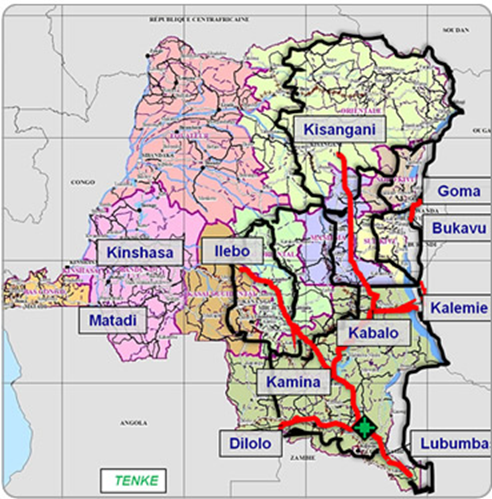
SNCC network in detail (+ Haut Uélé):

In coordination with the implementing agencies, the Ministries of Finance and Transport, the project aims to commit $631 million for renewing tracks, trains and boats to improve the competitiveness of the SNCC for exporting goods and minerals. 2015 was an important year for the project as the first brand new locomotives (from China) were delivered to Lubumbashi.

New locomotive on the SNCC network.
For more information on the project, please see The World Bank's DRC Multi-modal Transport Project Implementation Status & Results Report.
The project suffered some delays due to the structural problems inherited from the past, such as staff recruitment, staff volume and deficient management at all levels (financial, technical, commercial). An external problem appeared as the SNCC complained of the damages on the infrastructure caused by looters digging under the rail tracks to get earth containing copper fallen from the wagons.

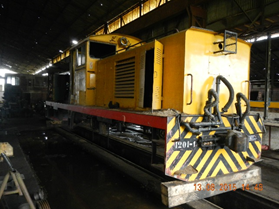
Kisangani station (the train foreground, loaded with iron sheets for a Development agency, has been standing for months). The locomotive is under repair until new ones are delivered (2016).
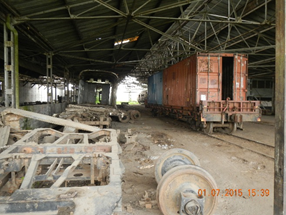
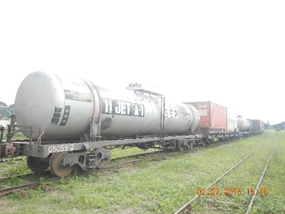
Kindu station: workshop and fuel tanker (here aviation fuel).
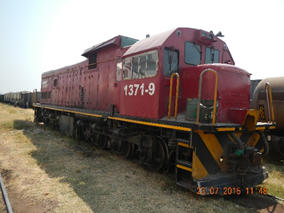
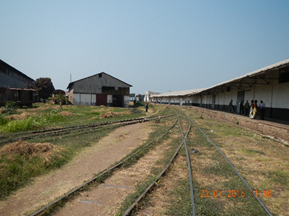
Kalémie station: one locomotive (without fuel) and tracks with large warehouses along them.
SCTP
The rail part of the SCTP’s activity is composed of the Matadi-Kinshasa corridor. It has been recently rehabilitated and operates several times a week.
In the past, the company was able to run up to 20 convoys simultaneously and had more than 3,000 wagons, but now only two trains can circulate between Matadi and Kinshasa and the company has only 250 wagons and 4 locomotives.
The train is in direct competition with the transportation by trucks but has some advantages:
- Price is competitive ( $70 / ton)
- Transit time is approximately the same: 7 hours
- The train can enter Kinshasa at any time (restrictions apply on trucks)
- One train can pull the equivalent of minimum 30 heavy duty trucks
However:
- Loading/offloading of wagons can delay train departures
- In case of mechanical problems, the SCTP has little and slow means to fix problems
- There are is not enough wagons in circulation so the company is often missing units where needed.
- For economical reasons, a train doesn’t leave until a certain number of loaded wagons is reached

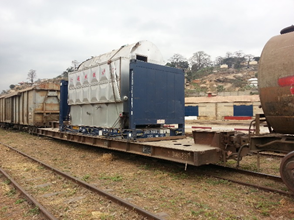
The Matadi train station is directly connected to the port and containers can be directly loaded from vessels to train.
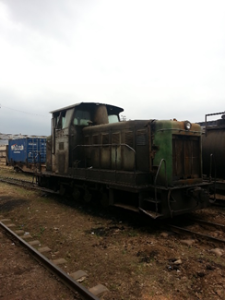

There was no locomotives (only this one for maneuvers) on the day of visit: they were all in Kinshasa so trains couldn’t leave.
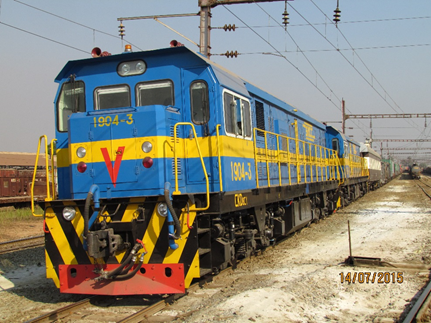
New locomotive on the Matadi-Kinshasa line (SCTP).
For information on Democratic Republic of Congo railway contact details, please see 4.1 Democratic Republic of Congo Government Contact List.
Capacity Table
|
Rail Operator Capacity |
|
|---|---|
|
SNCC |
|
|
Operates on (lines) |
See map |
|
Max train length and/or pulling capacity |
8 wagons of 40 Metric Tons |
|
Locomotives (electric/diesel/steam) |
Diesel or Electric |
|
Freight Wagons (covered) / size |
12 m length, 2.5 m width |
|
Freight Wagons (flat bed) / size |
16 m length |
|
Freight Wagons (high-sided)/size |
16 m length |
|
Freight Wagons (drop-side)/size |
n/a |
Key Route Information
- The SNCC rail network is in the southeast of the Democratic Republic of Congo, and is the only cross-border railway network in sub-Saharan Africa. The railway covers 3,641km but most parts are in poor condition or complete disrepair. SNCC could be useful as a link to Durban and Dar es Salaam ports, but the railway's slow operations and high costs make road travel a more practical option. Today, the railway holds about one-tenth of the traffic it held in 1970. One section of the railway runs from Kolwezi, near the Zambian border, through Katanga, and to Ilebo. The track from Ilebo to Kinshasa has gone missing, so road or river transport is required between these two areas. Transport along the SNCC is about three times more expensive than it is on other railways in southern Africa. The cost of SNCC rail freight is about $0.15/MT.
- The Matadi-Kinshasa rail line (links to the Port of Matadi). The railway from Matadi to Kinshasa was built in the 1890s and is 366 km long.
- The third and last railway network in the Democratic Republic of Congo is the Chemin de Fer des Uélés (Uélés Railway - CFU), a 1,026 km long 0.6 meter gauge line in the north of the country (linking the Kilo Moto gold mines to the Congo River). It is currently not operational.
Main international railway lines:
- TAZARA railway links the Southern African regional transport network to East Africa and the rest of the world through the East African seaport of Dar es Salaam. It runs from the port of Dar es Salaam in Tanzania to the Town of Kapiri Mposhi in Central Zambia where it links with the existing Zambia Railways system and connects to the Congolese Railways, SNCC. The gauge of the line is 1,067 millimetres (three and half feet), also known as the "Cape Gauge." The gauge of the TAZARA line is the same as that of Zambia Railways and all the other main trunk lines in Central and Southern Africa.
- Dar es Salaam-Kigoma, Tanzania rail line (links to Kigoma port). The railway from Dar es Salaam to Kigoma, Tanzania is 1,254 km long, and serves parts of North Kivu, South Kivu, and Katanga provinces for the Democratic Republic of Congo. Goods arriving in Kigoma from Dar es Salaam by rail would then be transported by boat to Bujumbura (12 hours) and Kalemie, the Democratic Republic of Congo (12-18 hours). Goods arriving by boat to Bujumbura would then be off-loaded and trucked to Bukavu, Goma and further points inside the Democratic Republic of Congo.
- From Dar es Salaam / To Zambia
General overview:
The Tanzania-Zambia Railway Authority, popularly known by the acronym TAZARA, is a bi-national railway, jointly owned by the Government of the United Republic of Tanzania and the Government of the Republic of Zambia on an equal share-holding basis. The 1,860 km-rail runs from Tanzania and East Africa’s major seaport of Dar es Salaam into the heart of Zambia’s Central Province, terminating at New Kapiri-Mposhi, where it is further linked by road and rail to Zambia’s capital city, Lusaka (about 200 km), Zambia’s mining nerve centre, the Copperbelt province (about 100 km) and the Democratic Republic of Congo (DRC).
|
Standard Route Information |
|
|---|---|
|
Track gauge |
1,067 mm (3’6”) |
|
Ruling gradient |
Maximum 23 per thousand |
|
Total track distance (single and/or double) |
720 km(Kalemie-Kdu); 1,320 km(LBB-Klm); 1,488 km(Lbb-Kdu) |
|
Type of rail (weight and if welded or not) |
29 km/m in elementary rods of 10m, 29km/m in elementary rods of 16m and 24km/m in elementary rods of 7m |
|
Type of sleeper and fastenings |
Fixed metallic ties (CFL and BCK) 29 km/m |
|
Total track travel time |
See above |
|
Maintenance (Good, marginal, bad) |
Marginal |
|
Companies-consortiums operating on line |
SNCC |
|
Traffic frequency (monthly/weekly/daily) |
Weekly |
|
Security (Good, marginal, bad) |
Marginal |
|
Main stations (Add details below) |
Kalemie, Nyemba, Nyunzu, Kabalo, Kongolo, Samba, Kibombo and Kindu |


